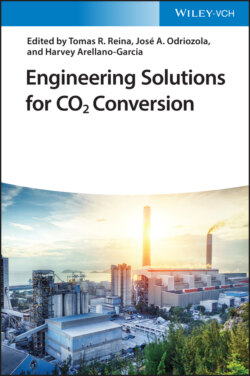Читать книгу Engineering Solutions for CO2 Conversion - Группа авторов - Страница 53
3.5.1 Electrolysis and Co‐electrolysis Processes
ОглавлениеThe equivalent energy required for the water and carbon dioxide split reaction (ΔH) is determined from the free energy and the entropy as follows:
(3.11)
where the electrical energy needed for the electrolysis will be defined by the free energy term (ΔG), whereas the thermal energy is defined by the entropy term (ΔS). As can be seen in Figure 3.6, the enthalpy of the water splitting reaction drops sharply at 100 °C because of the phase transition from liquid water to steam. In addition, the electrical energy needed for the electroreduction of water and carbon monoxide decreases as the temperature is increased. Furthermore, as temperature increases, the enthalpy of the CO2 electrolysis decreases. Therefore, by increasing temperature and operating at higher temperatures, the system will work more efficiently. Reaction kinetics are also enhanced at higher temperatures, which indicates higher H2 or/and CO production at the same operation voltage.
Figure 3.6 Enthalpy and free energy of CO2 and H2O reduction reactions and water gas shift reaction (WGSR). The present figure has been taken from the Grave's review.
Source: Graves et al. [102].
If co‐electrolysis is conducted, the WGSR has to be taken into account, and the system becomes more complicated. At temperatures above the zero free energy, reverse water gas shift reaction (RWGSR) is favored. As results, co‐electrolysis is usually run by systems that work at high temperature (solid oxide electrolyzers).
